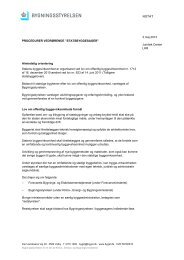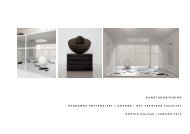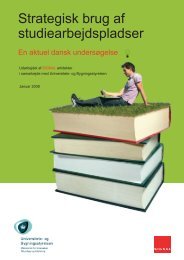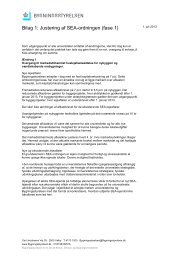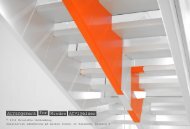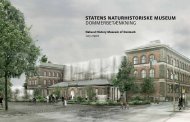Campus og studiemiljø - Bygningsstyrelsen
Campus og studiemiljø - Bygningsstyrelsen
Campus og studiemiljø - Bygningsstyrelsen
Create successful ePaper yourself
Turn your PDF publications into a flip-book with our unique Google optimized e-Paper software.
learning is. We build learning spaces in accordance with ideals of the<br />
past, he writes. Should we then change and renovate all our classrooms?<br />
Probably not. But maybe we should experiment more?<br />
MIT has taken a significant step in this direction. At a time where<br />
many would like large lecture halls in order to be able to present lectures<br />
to a lot of people in one go, the university has done away with one<br />
of its two large lecture halls. It used to seat 300 people in a traditional<br />
set-up with folding seats. The lecture hall has now been transformed to<br />
accommodate 100 students seated in groups around round tables with<br />
enough space for the group members’ laptop computers. The teacher is<br />
placed in the centre by a mixing desk from which he/she can pick out<br />
relevant work from the groups. The room still supports traditional lectures,<br />
but primarily problem-solving in group work. MIT has used this<br />
room for a couple of years, and experience shows that this layout and<br />
teaching form can pull particularly weak students up to a higher level.<br />
It is far from all ICT-supported learning activities that require new<br />
physical room types. Interchanges between students from several<br />
parts of the world at the same time only require mobile equipment<br />
and easily take place in flexible workshop-like rooms.<br />
In other situations, a more stationary set-up is needed to ensure<br />
reliability. MIT transmits lectures live to the University of Singapore<br />
and vice versa several times a day. This happens from three minor<br />
lecture halls, equipped especially for transmissions, i.e. they are<br />
better soundproofed and without daylight. These three rooms in the<br />
basement below the university make it possible for MIT’s teaching<br />
staff to be heard across the world, just as students can easily collaborate.<br />
MIT is now adding more rooms like this in keeping with<br />
an increasing demand. It seems to be a quick and cheap way for the<br />
university to establish itself and create visibility in other countries<br />
or continents.<br />
Studies indicate that although ICT can be integrated into many<br />
existing spaces, new teaching types and ICT possibilities will emerge<br />
that will require new spaces. Design and fitting out of classrooms<br />
will change and supplement the types we know already. Maybe the<br />
traditional lecture hall will become an arena characterised by not<br />
having a hierarchy, and in which you collaborate and perform for<br />
each other. The corridors will develop into an academic landscape in<br />
which you disseminate knowledge and perhaps involve passers-by<br />
in the academic work.<br />
163





